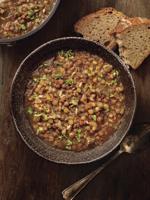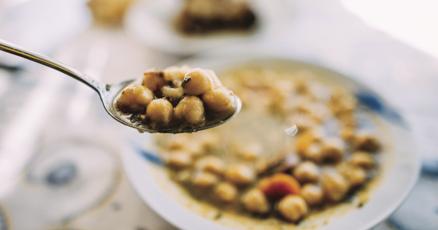------Advertisement-----
While it’s still a few weeks away, before you know it, Purim will be here.
Let me begin by introducing myself. I’m a new regular writer for the Detroit Jewish News, and I’m excited that each month I’ll be sharing recipes that I’ve vetted. Don’t hesitate to reach out if there are particular recipes you would like to see.
While it’s still a few weeks away, before you know it, Purim will be here. The holiday of Purim is associated with several food-based mitzvot, including giving gifts of food and enjoying a festive meal on Purim afternoon, as well as a number of traditional foods.
------Advertisement-----
While hamantashen are the most ubiquitous Purim food here in the U.S., they are certainly not the only one. Other traditional foods from around the world are characterized by a few key themes: representations of Haman, the holiday’s villain; foods with hidden fillings, representing the hidden identities that exist in the Purim story; and foods with legumes and seeds, representing the diet of Esther, the holiday’s heroine, who, legend has it, was trying to maintain her observance of Jewish dietary laws while also concealing her Jewish identity.
This legend of Esther really resonated with me, especially in these current times. Food is a source of nutrition, but it is also a representation of our identity, both in private and in public. In college, I lived abroad for a semester in Brussels and a semester in Hong Kong. Keeping kashrut during those journeys meant that I couldn’t eat all the local delicacies, and it was a constant reminder to myself that I was different and, in particular, that I was Jewish. While it wasn’t always convenient to make my way across the city on public transportation to procure kosher meat, it reminded me and those around me of who I was.
------Advertisement-----
In recent months, we’ve seen an increase in antisemitic acts, which Jews have responded to in different ways. On the one hand, we might feel empowered to publicly show our Jewish identity by wearing kippot or Jewish star necklaces or other items. On the other hand, we might feel that it is not safe to do so. Both of these feelings are valid, and we can perhaps look to Esther as a model for how to balance these competing feelings.
In honor of Esther, I share a number of legume- and seed-based recipes. I hope you are able to enjoy these recipes and reflect on how your choices reflect your identity and what that means for how you want to be seen in the world. I also hope they provide a nice balance to any abundance of hamantashen you might be enjoying for the holiday!

Creamy Lentil Vegetable Soup
Adapted from Beth Moncel, Budget Bytes
Makes 4 servings
Pareve
Ingredients
16 oz. mushrooms, rinsed and thickly sliced
2 tbsp. cooking oil
3 carrots, diced
3 ribs celery, diced
1 yellow onion, diced
2 cloves garlic, minced
½ tsp. dried thyme
½ tsp. rubbed sage
½ tsp. dried rosemary
1 c. brown lentils
3 c. vegetable broth
1 (13.5-oz.) can full-fat coconut milk
Salt and pepper to taste
Instructions
Add the mushrooms to a large soup pot or Dutch oven along with the cooking oil and a pinch of salt and pepper. Sauté the mushrooms over medium heat until the mushrooms have released all of their water, and it has evaporated out of the pot.
Add the carrot, celery, onion and garlic to the soup pot along with the thyme, sage and rosemary. Continue to sauté the vegetables until the onions are soft and translucent.
Add the lentils and vegetable broth to the pot. Stir to combine, then place a lid on the pot and turn the heat up to high. Allow the soup to come to a boil, then reduce the heat to medium-low and let it simmer for about 20 minutes, or until the lentils are tender.
Once the lentils are tender, add the coconut milk, stir to combine, and let it simmer for another five minutes.
Finally, season with salt and pepper to taste.
Spiced Chickpea Stew with Coconut and Turmeric
Adapted from Alison Roman
Makes 4-6 servings
Pareve
Ingredients
¼ c. olive oil, plus more for serving
4 garlic cloves, chopped
1 large yellow onion, chopped
1 (2-inch) piece ginger, finely chopped
Kosher salt and black pepper
1½ tsp. ground turmeric, plus more for serving
1 tsp. red-pepper flakes, plus more for serving
2 (15-oz.) cans chickpeas, drained and rinsed
2 (13.5-oz.) cans full-fat coconut milk
2 c. vegetable stock
1 bunch Swiss chard, kale or collard greens, stems removed, torn into bite-size pieces
1 c. mint leaves, for serving
Instructions
Heat oil in a large pot over medium heat. Add garlic, onion and ginger. Season with salt and pepper, and cook, stirring occasionally, until onion is translucent and starts to brown at the edges, 3 to 5 minutes.
Add turmeric, red-pepper flakes and the chickpeas, and season with salt and pepper. Cook, stirring frequently, so the chickpeas sizzle and fry a bit in the spices and oil, until they’ve started to break down and get a little browned and crisp, 8 to 10 minutes. Remove about a cup of chickpeas and set aside for garnish.
Using a wooden spoon or spatula, further crush the remaining chickpeas slightly to release their starchy insides. (This will help thicken the stew.) Add coconut milk and stock, and season with salt and pepper.
Bring to a simmer, scraping up any bits that have formed on the bottom of the pot. Cook, stirring occasionally, until stew has thickened, 30 to 35 minutes. (Taste a chickpea or two, not just the liquid, to make sure they have simmered long enough to be as delicious as possible.) If after 30 to 35 minutes, you want the stew a bit thicker, keep simmering until you’ve reached your desired consistency.
Add greens and stir, making sure they’re submerged in the liquid. Cook until they wilt and soften, 3 to 7 minutes, depending on what you’re using. (Swiss chard and spinach will wilt and soften much faster than kale or collard greens.) Season again with salt and pepper.
Divide among bowls and top with mint, reserved chickpeas, a sprinkle of red-pepper flakes and a good drizzle of olive oil.
Chia Seed Pudding
Makes 4 servings
Pareve
Chia seeds have gained much popularity for their healthy fats and fiber, and they become quite plump when hydrated, producing a creamy pudding-like consistency when combined with your favorite milk. I like this recipe because it feels light and refreshing, and the minimal ingredients allow the flavors of each of them to shine.

Ingredients
1 (13.5-oz.) can light coconut milk
½ c. chia seeds
2 tbsp. maple syrup
½ tsp. cinnamon
Pinch of salt
Instructions
Combine all ingredients in a lidded quart-sized mason jar. Secure the lid and shake to combine. Chill in the refrigerator for 1-2 hours. Shake or stir to break up any clumps that may have formed. Refrigerate overnight or at least 6 hours. I like to eat this as is, but you can serve with your favorite fruit or other topping. Feel free to substitute your favorite milk, though that may alter the texture — if the pudding is thinner than you would like, add more chia seeds, shake or stir, and refrigerate for at least an hour.
Dr. Joelle Abramowitz works as an economist at the University of Michigan’s Institute for Social Research and also writes about food and life.


